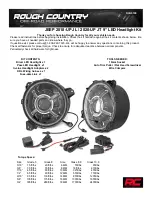
187
Starting and driving
Driving with a load
The driving characteristics of the car are
affected by the way it is loaded.
• Place heavy loads as far forward and as
low as possible in the trunk.
• Secure the load to the tie downs, see
page 141.
• The load should be such that the car´s
total weight or axle weight are not
exceeded, see page 258.
• Heavy loads mean that the car’s center of
gravity is further back. As a result, the car
will sway more during evasive steering.
• Never exceed the permissible load in the
roof box, even if there is room for more.
• Ensure that the tire pressure is correct –
slight overinflation is preferable to under-
inflation.
• The braking distance of a loaded car is
always greater. Keep your distance from
the vehicle in front.
• Roof loads can negatively affect tele-
communication.
Tire pressure, see page 269 and back
cover.
Tires
The tire pressure should match the current
load and speed of the car; see page 268 or
the tire pressure label on
page 269.
The tire pressures given apply to cold tires,
that is tires that are the same temperature
as the outside air temperature.
The tire pressure increases as the tires
become warm (e.g. during highway driving)
with approximately 0.3 bar (4 psi). When
the temperature of the tires changes by 50°
(10°C), the tire pressure will change 0.1 bar
(2 psi).
Never reduce the pressure of a hot tire. If the
tires are hot when you check them, only
increase the pressure, if necessary.
Underinflated tires wear more quickly than
slightly overinflated tires.
If a valve is leaking, simply unscrew it and fit
a new one.
Important! Remember to adjust the tire
pressures if you change the load in the car
or intend to drive at substantially lower or
higher speeds than normal.
WARNING
Check the tire pressure at least once a
month and before long journeys. Under-
inflation can result in:
• Punctures
• Separation of the tire and tread
• Damage to the sidewalls
• Damage to the rims on poor roads
• Poor handling characteristics
• Premature tire wear
• Increased fuel consumption.
Summary of Contents for 2003 9-5 2.3 Turbo Ecopower
Page 11: ...11 Safety Safety Seats 12 Head restraint 16 Safety belts 17 Child safety 23 Airbag 33 IB1740...
Page 41: ...41 Security Security Doors 42 Central locking 42 Car alarm 48 IB446...
Page 54: ...54 Security This page has been left blank...
Page 88: ...88 Instruments and controls This page has been left blank...
Page 110: ...110 Saab 9 5 Audio System This page has been left blank...
Page 272: ...272 Specifications This page has been left blank...
Page 277: ...277 Notes Notes...
Page 278: ...278 Notes...
Page 279: ...279 Notes...
Page 280: ...280 Notes...
Page 281: ...281 Notes...
Page 282: ...282 Notes...
Page 283: ...283 Notes...
Page 284: ...284 Notes...
Page 285: ...285 Notes...
Page 286: ...286 Notes...
Page 287: ...287 Notes...
Page 288: ...288 Notes...
















































